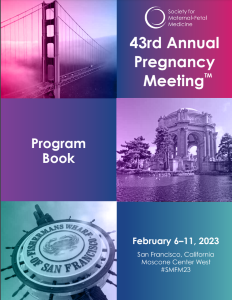Category: Medical/Surgical/Diseases/Complications
Poster Session III
(767) Gestational Weight Gain and Preeclampsia with Severe Features in Patients With Super Morbid Obesity.
To examine preeclampsia (PEC) with severe features in patients with body mass index (BMI) 60 kg/m2 or greater at the time of delivery who had gestational weight gain (GWG) below, within, or above Institute of Medicine (IOM) guidelines.
Study Design:
This was a retrospective study of women with BMI 60 kg/m2 or greater at the time of delivery who delivered at 23 weeks’ gestation or greater from 2009-2020. Patients with missing information on GWG, gestational age, or with multiple gestations were excluded. The primary outcome was PEC with severe features. Secondary outcomes included other hypertensive disorders of pregnancy (HDP), PEC without severe features, preterm birth (PTB), postpartum hemorrhage (PPH), postpartum emergency department (ED) visits and neonatal intensive care unit (NICU) admission. Adjusted odds ratio (aOR) with 95% confidence interval (95% CI) were calculated, controlling for chronic hypertension, parity, and gestational diabetes.
Results:
Of 425 patients, 130 (30.5%), 75 (17.6%), and 221 (52.0%) had GWG below, within, and above the IOM guidelines. Patients with GWG above the IOM guidelines were more likely to be nulliparas and to have a higher BMI at the time of delivery compared to patients with GWG below or within the IOM guidelines (Table 1). The rates of PEC with severe features, HDP, PTB, postpartum ED visit, and NICU admission were significantly different among the groups (P < 0.05) (Table 2). Patients with GWG above the IOM guidelines compared to those within were more likely to have PTB (21% vs. 9%; aOR 2.57; 95%CI 1.08-6.13) and postpartum ED visit (24% vs. 9%; aOR 2.90; 95%CI 1.24-6.80). Patients with GWG below the IOM guidelines compared to those with GWG within the IOM guidelines were less likely to have PEC with severe features, but more likely to have PTB and postpartum ED visit (Table 2).
Conclusion: In patients with BMI 60 kg/m2 or greater, GWG below the IOM guidelines was associated with decreased odds of PEC with severe features. Both GWG below and above the IOM guidelines were associated with PTB and postpartum ED visit compared to within IOM guidelines.

Jerri A. Waller, MD (she/her/hers)
MFM Fellow
Eastern Virginia Medical School
Norfolk, Virginia, United States- PK
Priyanka Kumar, MD,BS
University of Virginia
Charlottesvle, Virginia, United States 
Carole Barake, MD
University of Texas Medical Branch
Galveston, Texas, United States.jpg)
Stacey Gold, MD
MedStar Washington Hospital Center
Washington, District of Columbia, United States
Alfred Abuhamad, MD
President, Provost and Dean
Eastern Virginia Medical School
Norfolk, Virginia, United States
Tetsuya Kawakita, MD, MS, FACOG
Assistant professor
Eastern Virginia Medical School
Norfolk, Virginia, United States

.png)
